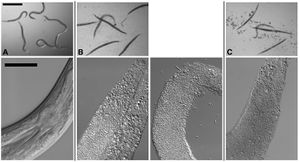Bacillus thuringiensis toxin in C. elegans: Difference between revisions
Adrianowyczs (talk | contribs) |
Adrianowyczs (talk | contribs) No edit summary |
||
| Line 2: | Line 2: | ||
[[Image:Wei2003_1.jpeg|thumb|300px|right|(B) Photographs | [[Image:Wei2003_1.jpeg|thumb|300px|right|(B) Photographs | ||
of the anterior intestine of nematodes fed the four toxic crystal proteins in E. coli. Arrowheads delineate the width of the intestine at one position near the | of the anterior intestine of nematodes fed the four toxic crystal proteins in E. coli. Arrowheads delineate the width of the intestine at one position near the | ||
anterior. (Bar 5 20 mm.)]] | anterior. (Bar 5 20 mm.)<http://www.pnas.org/content/100/5/2760.long/>]] | ||
[[Image:Kho2001_1.jpg|thumb|300px|right|Figure 1. Infection of C. elegans by B. thuringiensis and B. anthracis. Top row: Dissecting microscope view of nematodes cultured under various | [[Image:Kho2001_1.jpg|thumb|300px|right|Figure 1. Infection of C. elegans by B. thuringiensis and B. anthracis. Top row: Dissecting microscope view of nematodes cultured under various | ||
conditions. Scale bar of all images in top row is 500 mm. Bottom row: Compound microscope view of nematodes cultured under various conditions. | conditions. Scale bar of all images in top row is 500 mm. Bottom row: Compound microscope view of nematodes cultured under various conditions. | ||
| Line 11: | Line 11: | ||
structures and normal coloration); one is not. Bottom row: Infected animals show complete or near complete digestion of internal structures by the | structures and normal coloration); one is not. Bottom row: Infected animals show complete or near complete digestion of internal structures by the | ||
bacteria. Vegetative and sporulated bacteria can be seen in these lethally infected animals. (C) Similar images as in (B) except the bacterium cultured | bacteria. Vegetative and sporulated bacteria can be seen in these lethally infected animals. (C) Similar images as in (B) except the bacterium cultured | ||
with the nematodes is Bacillus anthracis.]] | with the nematodes is Bacillus anthracis. <http://www.plosone.org/article/info%3Adoi%2F10.1371%2Fjournal.pone.0029122/>]] | ||
[[Image:Luo2013_1.jpg|thumb|300px|right|Growth assay of L1 larvae | [[Image:Luo2013_1.jpg|thumb|300px|right|Growth assay of L1 larvae | ||
of C. elegans with Cry6Aa2 | of C. elegans with Cry6Aa2 | ||
| Line 25: | Line 25: | ||
for each toxin concentration. | for each toxin concentration. | ||
Error bars denote standard | Error bars denote standard | ||
deviation]] | deviation <http://link.springer.com/article/10.1007%2Fs00253-013-5249-3/fulltext.html/>]] | ||
<br>By Sarah Adrianowycz<br> | <br>By Sarah Adrianowycz<br> | ||
<br>At right is a sample image insertion. It works for any image uploaded anywhere to MicrobeWiki. The insertion code consists of: | <br>At right is a sample image insertion. It works for any image uploaded anywhere to MicrobeWiki. The insertion code consists of: | ||
Revision as of 00:25, 22 April 2014
Introduction



By Sarah Adrianowycz
At right is a sample image insertion. It works for any image uploaded anywhere to MicrobeWiki. The insertion code consists of:
Double brackets: [[
Filename: PHIL_1181_lores.jpg
Thumbnail status: |thumb|
Pixel size: |300px|
Placement on page: |right|
Legend/credit: (B) Photographs
of the anterior intestine of nematodes fed the four toxic crystal proteins in E. coli. Arrowheads delineate the width of the intestine at one position near the
anterior. (Bar 5 20 mm.)
Closed double brackets: ]]
Other examples:
Bold
Italic
Subscript: H2O
Superscript: Fe3+
Introduce the topic of your paper. What microorganisms are of interest? Habitat? Applications for medicine and/or environment?
Section 1
Include some current research, with at least one figure showing data.
